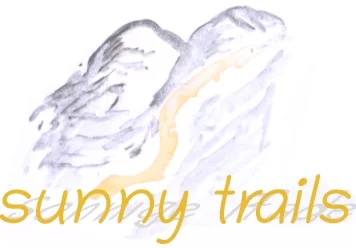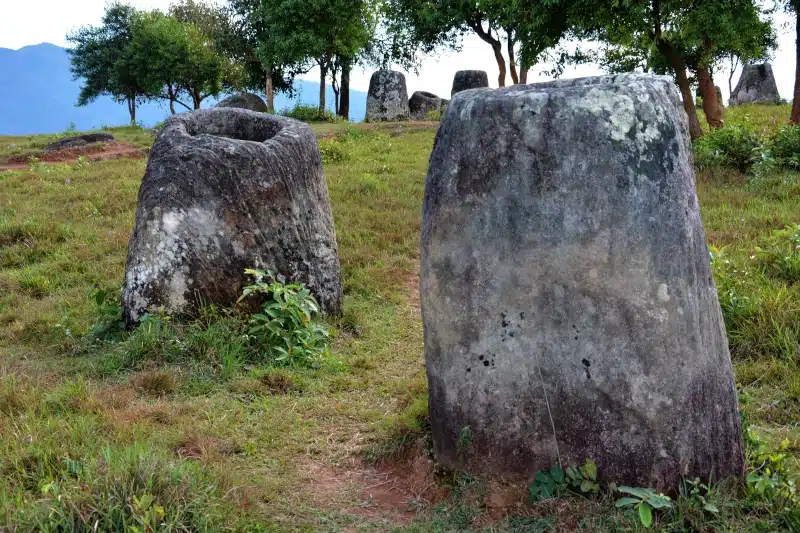
In the shimmering heat of the savannah-like landscape in northern Laos, dozens of stone jars stand or lie on the grass. Rarely are the origins of a „world cultural heritage“ so obscured in the darkness of the past as in the case of the „Plain of Jars“. Even the age of these man-made containers is largely uncertain – UNESCO assumes a date of origin between 500 BC and 500 AD. Their purpose is even more mysterious. For history buffs and visitors who want to learn more about the cultures of Southeast Asia, the Plain of Jars is one of the most peculiar destinations in Laos.
Mysterious history in Xieng Khouang in the north of Laos
The regional name „Ebene der Tonkrüge – german literally translated: Plain of the Clay Jars“ was already somehow a term for me from my childhood days – without me being able to assign it locally or really having an idea of what it was about. I suppose that the german name „Ebene der Tonkrüge“ was called more often because of the Indochina – war, which raged in this region very violently in this time, and also found its echo in east german newspapers.
Since I could profit as a child with the hours-long reading aloud of fairy tales, later also from the self-reading, in which it was about the „sweet porridge“, fat jugs and similar utensils, I connected the „plain of the clay jugs“ probably with a fantasy landscape from the fairy tale world and the designation could anchor itself so in my subconsciousness. Therefore, the plain of the jars immediately caught my eye during the preparations for my first Laos – trip and virtually urged on a visit.
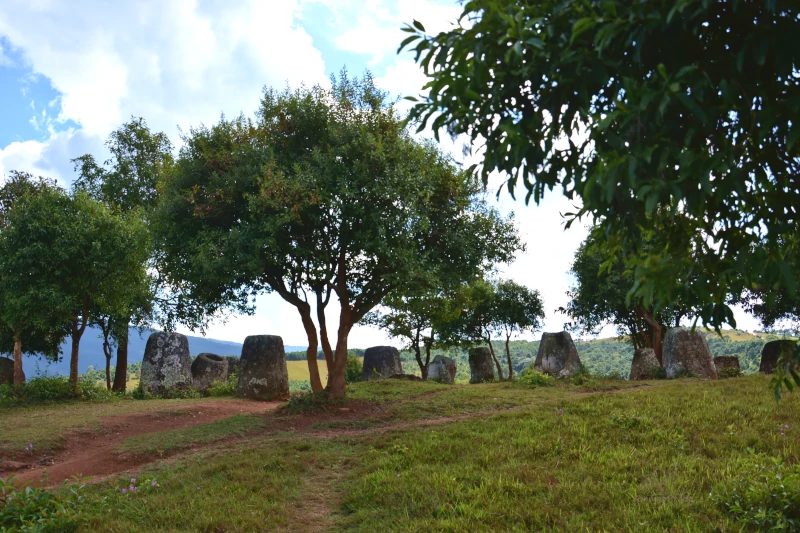
Stone jars of a past culture
But the reality on site has nothing to do with clay jars. Probably the regional designation plaine des Jarres from the French was simply wrongly translated in the German, because one understood at this time still predominantly burned stoneware – containers under des Jarres.
For the stone jugs of the plaine des Jarres are large pots made of hewn natural stone, which was probably extracted in quarries in the area especially for this purpose.
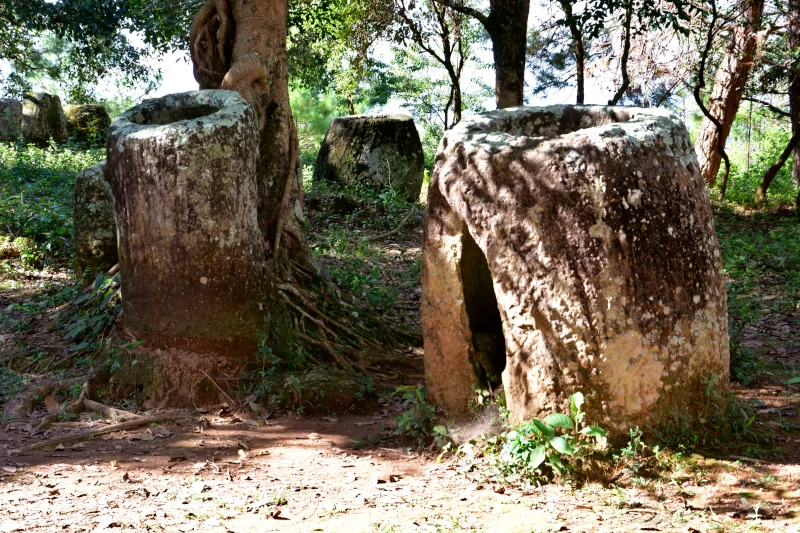
The height of most of these stone pots is about 1m, but there are also much larger specimens. These stand or lie, intact or partly also broken, in several fields, so called „jar sites“, of which three are in the meantime well accessible and safe concerning the remainders of the bombardments. In total, there are probably more than 50 larger and smaller jar sites, not all of which have yet been fully surveyed.
Individual visits to the „Plain of Jars“ – nature experience in the rural area of Laos
By moped or bicycle to the jar sites
The Plain of Jars is located in Xieng Khouang province in the north of Laos. The provincial capital is Phonsavan. From there you can easily explore the jar sites 1 – 3 on your own. For this you need your own means of transport – a bicycle or a moped or you can organize a cab on the spot. An entrance fee of about 15,000 Kip is charged for visiting each jar site.
Jar site 1 – Thong Hai Hin – is located relatively close to Phonsavan and can also be reached by bicycle. It is about 8km from the center of Phonsavan. The other Jar sites are further away, it will be difficult by bike. I visited all three jar sites in one day with a borrowed motobike (scooter). Since the roads are often only gravel paths, cycling becomes quite exhausting. In addition, there is the tropical heat.
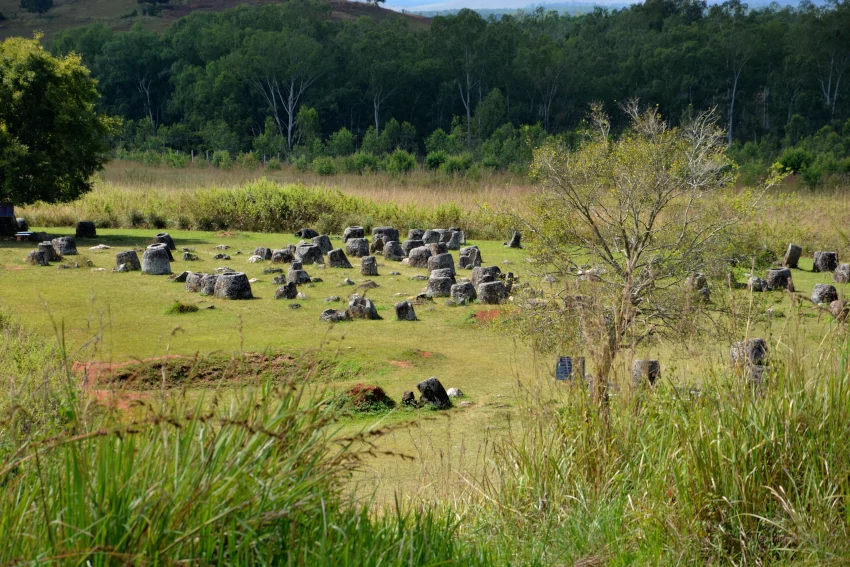
Nature experience in a rural setting
But the open, slightly hilly landscape provides a pleasant „setting“ around the stone jars, making this excursion an experience in rural Laos. Especially since the jar sites in the plain of the jars, except perhaps jar site 1 near the town of Phonsavan, are little visited. The jar sites with the stone jars are usually on a hill or on the slope of hills. For me, jar site 3 was the most interesting, as the access led over narrow clay embankments through harvested rice fields and past small, fenced-in vegetable gardens of the locals.
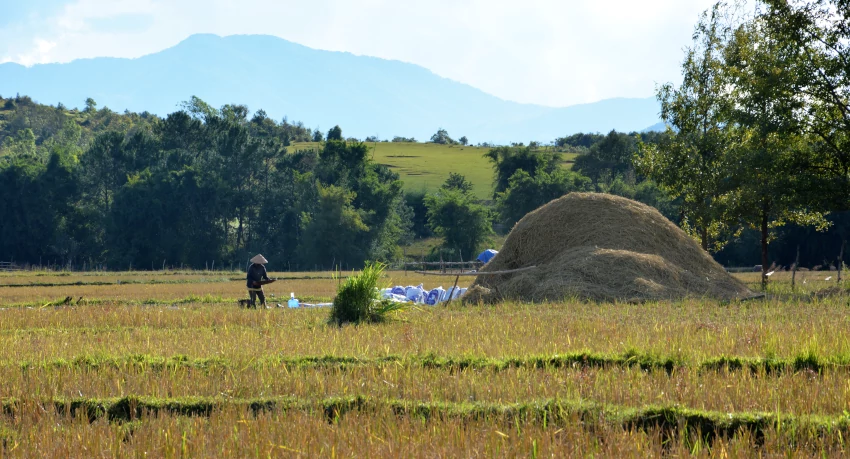
Jar site 2 Hai Hin Phou Salato and 3 Hai Hin Lat Khai are in park-like small groves, shaded and scattered. Especially here there are single stone jars, from which trees have grown out, whose seeds once fell into such a container, sprouted in the blown-in humus layer and in the course of time have blown up their „flower pot“. With a little luck or alert attention to the surroundings, one has on site encounters and nature experiences with the local fauna and flora, such as songbirds, butterflies, lizards or pretty flowering plants. On the way from jar site 2 to jar site 3 I also passed a small waterfall, Tad Lang waterfall.
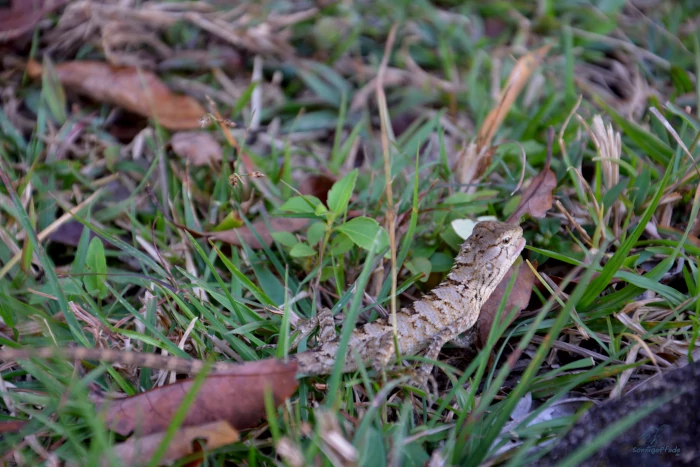
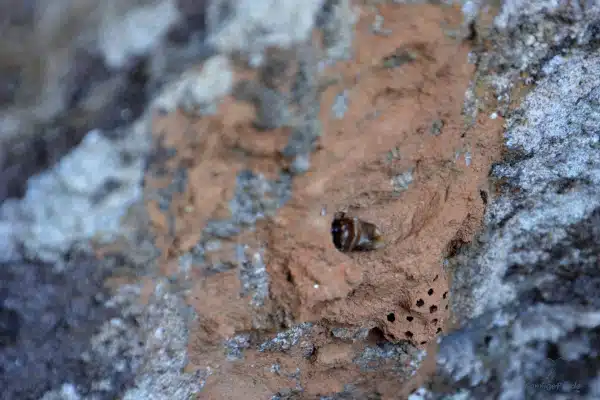
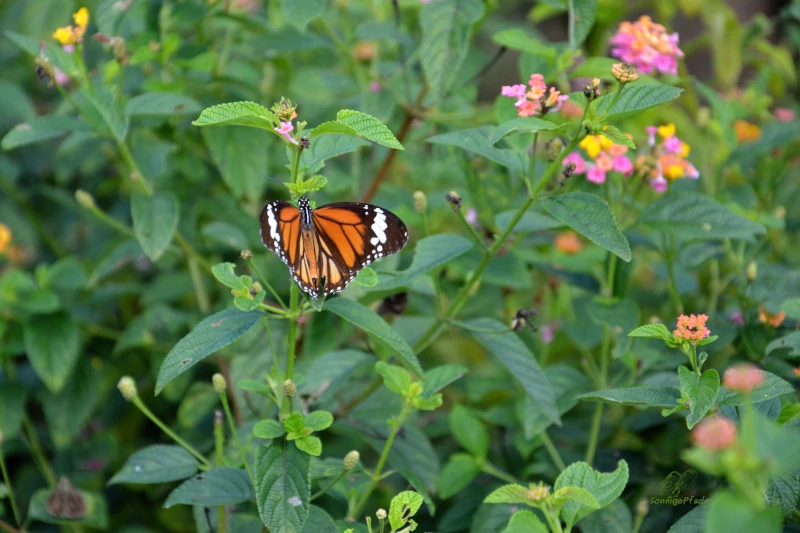
Exhibition at Jar site 1
At Jar site1 there is a small exhibition. Besides the few known facts about the „jars“ themselves, the main topic is the bombing of the „Plain of Jars“ around Phonsavan including the cultural and historical sites by the US Air Force. In the 1960s, there was a civil war in Laos and Xieng Khouang province was heavily influenced by the communist Phatet Lao. Fierce battles raged here, in which the USA also intervened directly by massive bombardment. Also the already known ground monuments on the plain of jars were not spared, so that many of the stone pots were damaged or destroyed.
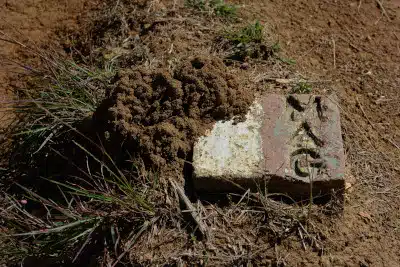
As a result, at least some of the jar sites had to be cleared of unexploded ordnance in order for the Plain of Jars to be recognized as a UNESCO World Heritage Site. At jar site 1 alone, 127 unexploded ordnance (UXO) were defused and over 31,000 pieces of bomb debris were found. This is the only way visitors can now safely enter these three archaeological sites. (A fourth site is probably in the works by now). The safe routes at the jar sites are marked with stones embossed „MAG“ embedded in the ground.
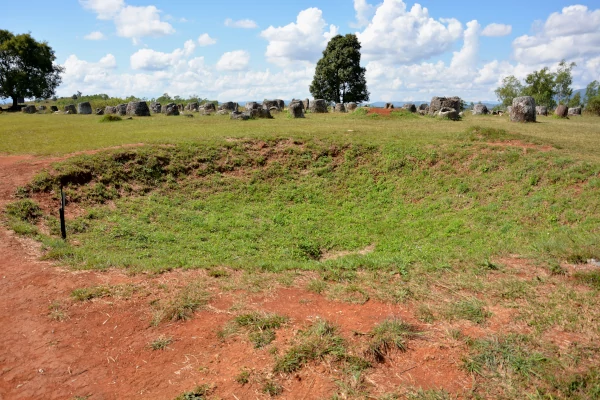
Archaeological and cultural-historical research in the plain of jars
The Plain of Jars was discovered or rediscovered around 1930 by the French archaeologist Madeleine Colani (*1866). She was engaged in Vietnamese early history for a long time and was traveling in the region. Colani was traveling for the École française d’Extrême-Orient and was the first to investigate the plaine des Jarres.
The purpose of these stone pots remains a mystery to this day. It is conceivable that they were used as storage vessels for foodstuffs such as rice, wine and other agricultural products. That large stone pots are well suited for this purpose has long been known and logical, as they repel moisture and keep away pests such as mice and other rodents.
The UNESCO theory
The most widespread theory about the plain of jars, which is also represented by the UNESCO so far, assumes that the stone pots were evidence of a megalithic burial culture. For this purpose, deceased persons are supposed to have been stored in the „jars“ until decomposition or the ashes of cremated persons. Bone finds have also been found in the vicinity of the jar fields, but not directly in the containers. It is therefore assumed that the bones were removed later and deposited in bone pits.
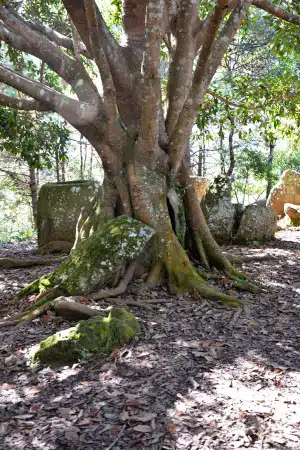
The age of the stone jars or the period of the cultural epoch in the early history of Laos is not finally clarified. The UNESCO represents the thesis (repeated on almost all websites on the subject) that it should have been an Iron Age burial culture in the period from 500 BC to 500 AD. In this period the ethnic classification in the region was determined by two cultural systems – the Mun-Mekong system and the Red River/Gulf of Tonkin system. At the plain of jars, these are said to have led to strong trade and cultural exchange, and the jar sites are an expression of these activities.
Divergent findings of Australian researchers
But there are also other theories. On the website „foto-reiseblog“ of the german author Reiner Kerner, who is well acquainted with Southeast Asia, I came across the hint that scientists of the Australian University of Melbourne, based on their investigations with the radiocarbon method, classify the activities in the plain of jars much earlier – namely already in the time between 1240 BC and 660 BC. That would be then again well 700 years older.
A short news item on yahoo news from 2016 makes reference to research by another Australian research team that looked at the purpose of the pots. The news quotes scientist Dougald O’Reilly, according to whom various burial forms could be analyzed in the vicinity of the jar sites – but no bones in the stone jars. In his opinion, the bones of deceased people could have been buried later, after decomposition had already taken place in the stone jars. However, he said, the stone jars remain a mystery.
Stone masons with high craftsmanship
The stone jars are evidence of high craftsmanship. The neat workmanship alone, the perfectly regular shapes and the settings for containers and lids are admirable. Some of the „pots“ are thicker, more bulbous, others are more cylindrical tubes. In a few places today there are still the matching lids, although these are relatively rare. Possibly the majority of the lids – being much lighter – were carried away by subsequent generations of people and used as building material? It is astonishing to what precise work experienced craftsmen were already capable in the Iron Age – or even earlier!

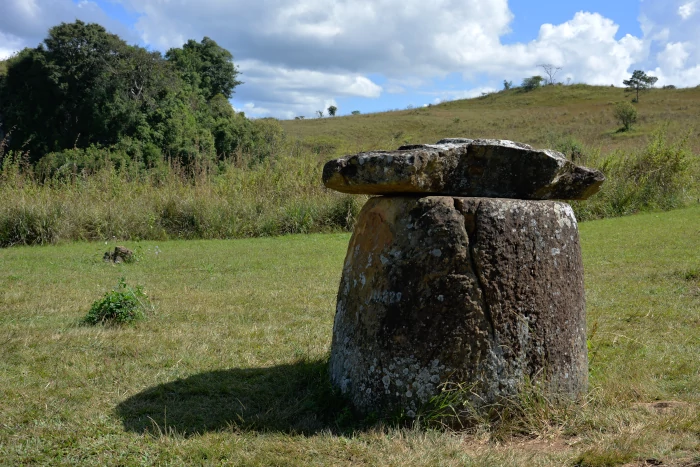
The provincial capital of Xieng Khouang – Phonsavan
Phonsavan is located in the northeast of Laos. This city is not a beauty. Unfortunately, the fighting and heavy bombing of the region by the US Air Force between 1964 and 1973 had an impact here as well. Phonsavan was rebuilt after the war in the concrete stilts – construction method widespread throughout South Asia, where columns of reinforced concrete support the ceiling slabs of 2 or 3 upper floors. Depending on the intended use, exterior walls and rooms are then walled, facing the street with or without balconies. On the ground floor there are usually iron shutters, behind which are hidden stores, storerooms, garages or whatever else.
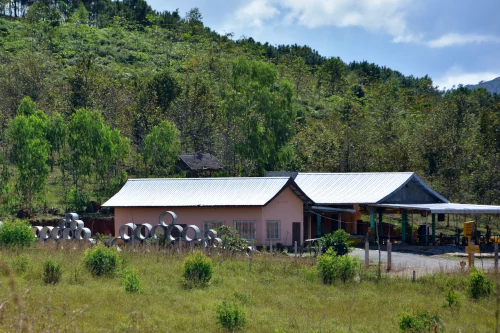
The main road 7 passes the town of Phonsavan from west (Luang Prabang) to east (towards the Vietnamese border), in the small center there is a market, bus station, post office, internet store, several local tour operators and bike and moped rental stations.
Several guesthouses offer rooms – my guesthouse on a quiet side street near Phonsavan market was very pleasant. Simple but clean and tidy.
MAG – Information Center UXO Lao and UXO – Victim Self-Help Center in Phonsavan
Close to each other on the main street are the MAG information center and a self-help information center with an exhibition of UXO victims (UXO – unexploded ordnaries). I recommend you to visit both!
The MAG UXO Information Center
MAG is the organization in Laos that has been trying for decades to find and defuse the munitions left over from the bombing war. This is done not only at the Plain of jars sites, but all over the country. And yet, unfortunately, this work will take many more decades.
Because in Laos, bombs were dropped somewhere about every 8 minutes during the 9 years of the war. Much of this was so-called cluster munitions, in which one container carried about 400 small „bombies“ designed to burst into tiny deadly fragments. It is estimated that of the approximately 270 million (!) bombies, 30% did not explode immediately. A large part of them is still in the ground today – in rice fields, playgrounds, fish ponds and bamboo groves.
And these bombies, 6 cm in diameter and painted orange-red rather like tennis balls or oranges, are still claiming victims every month to this day in Laos, almost 50 years after the end of the war. Most of those injured or killed by bombies are farmers and children.

On the way between jar sites, I saw MAG’s white trucks and jeeps in fields, as well as current roadside warning signs about new bomb discoveries. The MAG Info Center tells about the work of the MAG – munitions search is often done by women. In addition to active bomb search and defusing, an important part of the work is teaching children about the dangers of wartime debris and the proper way to behave when finding it.
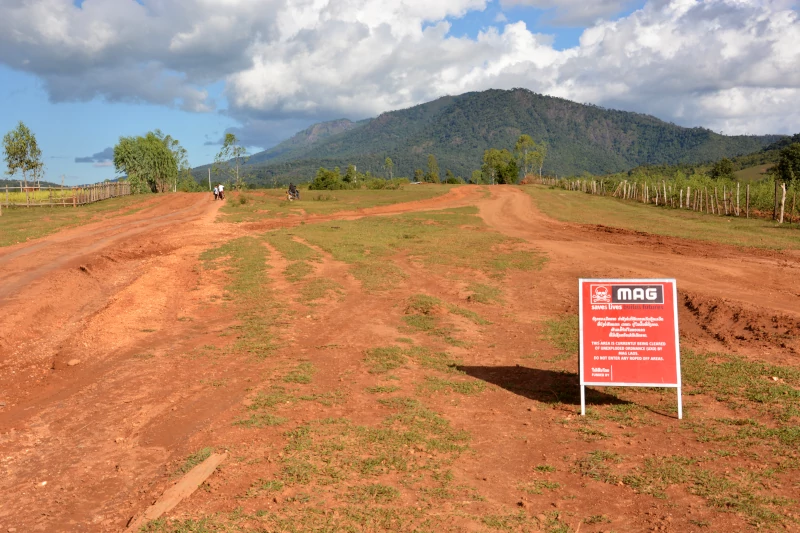
UXO – Victim Assistance – Exhibition
Impressive was the visit next door in an exhibition of the self-help organization of UXO – victims. From my childhood days I still have the memory of adult older men who were walking around in my hometown with crutches, wheelchairs and wooden legs and of whom it was said that they were war victims (from World War II). But they were relatively rare and today’s youth in Central Europe no longer knows such images. No miracle, if armament is tolerated again and war employments are decided times completely besides.
In Laos live numerous UXO – victims, unfortunately also still from recent time, who were torn by the splinters of the bombies, lost limbs or the eyesight and are often completely dependent on the assistance of relatives. Some of them try to organize physical rehabilitation and find meaningful occupations in self-help. Thus, handicraft and manual labor activities are developed to somehow produce usable items or saleable products – for example, everyday items or jewelry made from war scrap. A selection of these special Laos souvenirs can be purchased at the victim center.
The program of the exhibition also includes a small film (in English) about one of the UXO – victims from recent times, who triggered a bomb while putting a fence pillar at his property and survived with a lot of luck. I was also deeply affected by a board on which the 21 victims of the current year were noted with date and age – most of them were children and young people under 20 years of age.
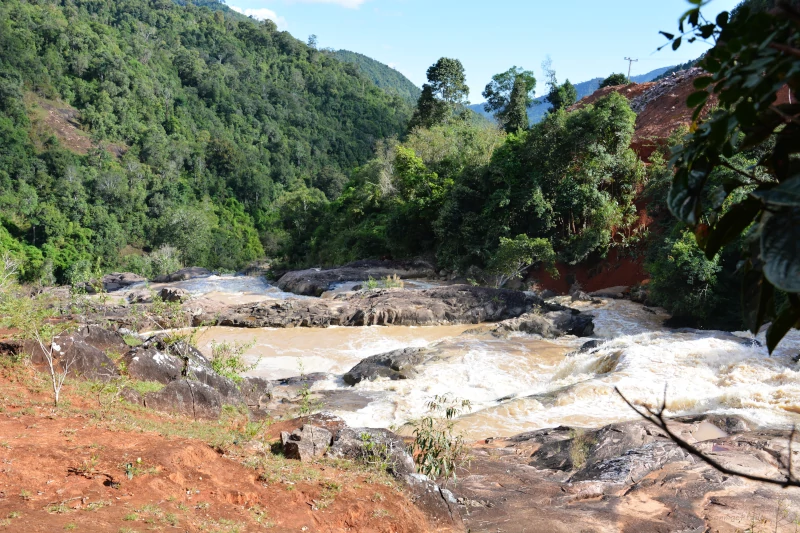
Getting to the Plain of Jars

The province of Xieng Khouang, where the Plain of Jars is located, can be reached by public bus from Luang Prabang (south bus station) or from the Lao capital Vientiane. Your first destination is the provincial town of Phonsavan. From Vientiane, a quick domestic flight is also possible to a limited extent (30 – 40€).
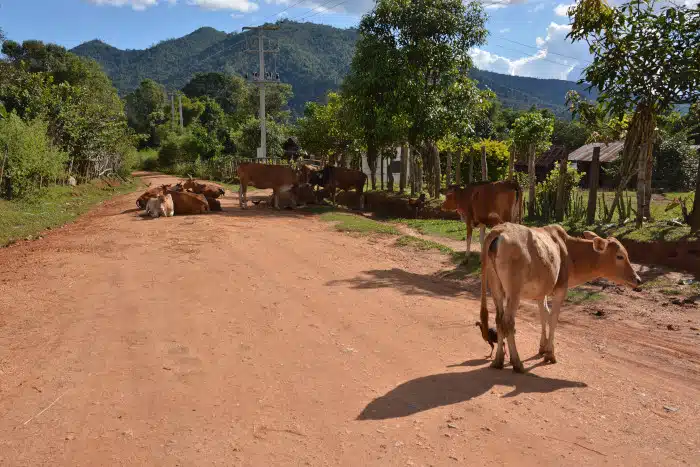
Accommodation in Phonsavan
In Phonsavan several guesthouses offer good accommodation*, which are not too expensive. Most of the time you can rent a scooter or a bike on the spot.
The most popular and best rated guesthouse in Phonsavan is Kongkeo Guesthouse*. The owner sometimes even organizes tours to the jar sites with his guests. There are different room types from single rooms to triple rooms, partly also in bamboo bungalows or even an 8-bed dormitory. Bicycles can be rented for a fee. There is a garden with a fireplace. Pick-up from the bus station is available upon request.

Also well rated are the twin and triple rooms at Sipanya Guesthouse*. These hosts also pick up guests from the bus station on request and organize tours to jar sites. There is also wheelchair accessible accommodation on the ground floor.
A few kilometers outside Phonsavan, but with the best reviews, Pukyo Bed and Breakfast* invites you to stay in twin rooms. There’s also a family room. An outdoor pool is operated seasonally. Bicycles can be rented at the property, and other vehicles are also arranged.
Phonsavan also has a ***hotel, the Phouluang Hotel*, but this is comparatively poorly rated by guests.
Can you solve the mystery of the jars? Invite your friends!
If you liked the post and would like to draw friends‘ attention to the „Plain of Jars“, please share the link to the post on your social media channels. Thank you!
Note on * advertising links
This post contains links marked with *. If you click on such a link and order or book something at the linked providers, the sunny trails blog receives a small commission to cover technical expenses. Nothing will be more expensive for you, because the commission is already taken into account in the pricing.
